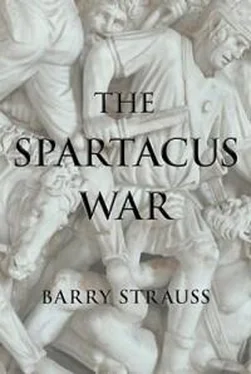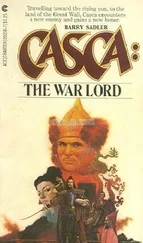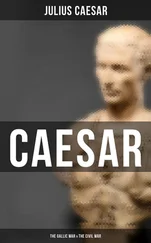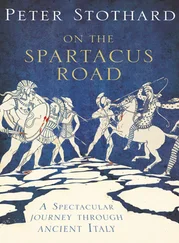A gladiator’s life expectancy was short. The best evidence comes from a cemetery at Ephesus, in Turkey, where 120 skeletons of gladiators have been excavated and studied. Almost all of them died before the age of 35, many before 25. Between a third and a half of them died from wounds violent enough to cut or shatter their bones - and about a third of those wounds were blows to the head. The other skeletons show no sign of bone damage, but the men might have died violently nonetheless, from dis embowelment or a severed artery or an infected flesh wound, for example.
The Ephesus gladiators lived during the period of the Roman Peace in the second and third centuries AD, when the games were a state monopoly. During Spartacus’s era, in the Late Republic, the games were run by private enterprise, and that probably made things worse for gladiators. Sponsors were usually rich men in search of popularity, and the crowd loved bloodshed, so they might have tried to outdo each other in the number of gladiators they sacrificed. It would not be surprising if many gladiators died in their first match.
And that match might have been looming on the horizon. The gladiators’ revolt began in the spring. It has been suggested that Vatia’s men were being trained for the annual Roman Games, also known as the Great Games, which began on 5 September. Gladiatorial contests were part of this two-week festival. With all Rome watching, the producer would have to give the crowd at least some blood. A number of Vatia’s gladiators could expect not to be coming home.
Still, the life-expectancy argument can go only so far. Thracians, Celts and Germans prided themselves on their contempt for death. They believed in the afterlife and they preferred to think of themselves as fearless fighters, not cowards. Spartacus had to convince them that there was a better fight waiting for them as fugitives than inside the ludus.
Gladiators wanted neither to flee nor to free others. But standing and fighting in Italy, killing Romans, stealing their wealth, and attracting supporters from the local slave population - that would have appealed to the men of the Familia Gladiatoria Lentuli Vatiae, Lentulus Vatia’s Family of Gladiators.
And yet, this catalogue of reasons somehow fails to explain Spartacus’s success. Surely, his personal authority has to be added to the equation. When Spartacus spoke, men listened. It wasn’t just his prowess in the arena, or his experience in the Roman army, or his possible reputation as a bandit. It wasn’t simply his royal-sounding name or his communications skills - although those were doubtless considerable. Something else, some ‘X’ factor, multiplied his authority. But what?
To answer that question, we will have to ask his woman.
Chapter 2 — The Thracian Lady
In 73 BC a Thracian woman announced a miracle. A prophetess, she preached the word of Dionysus, who took possession of her during ecstatic frenzies. The god, she said, had bestowed great power on a man. Like her, he was a Thracian who lived in Italy. He was her lover: Spartacus.
We know very little about the Thracian woman, not even her name. The surviving information, however, is tantalizing. She was Spartacus’s messenger, perhaps even his muse.
Although nothing is known of her appearance, we can imagine the kind of ecstatic ritual that might have led to her prophecy, because a great deal of information survives about the worship of Dionysus. Popular in many places in the Mediterranean, Dionysus was the national god of Thrace. Thracian women danced for Dionysus, and wore long, ankle-length robes, barefoot with their upper arms exposed. Thracian women tattooed their arms with such patterns as geometric stripes, chevrons, dots, circles and a fawn. A Bacchante (that is, worshipper of Dionysus) wore an ivy wreath in her hair. As she worshipped the god she typically held a thyrsus, a giant fennel staff topped with a pine cone. Beside her might have lain the tiny items that she used in her ritual: amber, seashells, knucklebone and glass. But the most striking object would have sat in her right hand: a snake. Its body would have been curled around her upper arm and through her armpit, while its head would have extended downwards towards the ground. Knowing that the snake was Dionysus’s main companion and symbol, she probably felt no fear.
Plutarch is our sole source [24] Plutarch, Crassus 8.4.
of information about the Thracian lady. He lived 150 years after Spartacus but he based his work on the now largely missing contemporary account of Sallust. What Plutarch says might not satisfy sceptics, but other sources make it plausible.
We meet the Thracian lady in Capua but we can imagine the process that brought her there. Consider a scene on a tombstone of a slave dealer [25] the Kapreilios Relief shows two women and two children accompanying a file of eight slaves marching in a chain gang, chained by the neck and preceded by a guard. See J. Kolendo, ‘Comment Spartacus devint-il esclave?’, in Chr. M. Danov and Al. Fol, eds., SPARTACUS Symposium Rebus Spartaci Gestis Dedicatum 2050 A.: Blagoevgrad, 20-24.IX.1977 (Sofia, Bulgaria: Editions de L’ Académie Bulgare des Sciences, 1981), 75, and M.I. Finley, ‘Marcus Aulus Timotheus, Slave Trader’, in Aspects of Antiquity, Discoveries and Controversies, 2nd edn (New York: Penguin, 1977), 154-66.
. Two women are walking, modestly dressed in ankle-length tunics, their heads covered by shawls. Two children walk beside them. Ahead of them walk eight men, chained to each other at the neck, their bare legs showing below knee-length tunics. Leading the march is a man in a full-length, hooded cloak. He is a guard or slave dealer; the eight men are being led off into slavery. The women and children may be family, following two of the men into bondage.
The scene took place some time in the Late Roman Republic or Early Empire. The place is Thrace; the slaves were Thracians, sold into slavery in exchange for wine. But they may remind us of Spartacus and his female companion on the road to slavery in Capua in 73 BC.
It may seem hard to believe that an enslaved gladiator was allowed to have a female companion. But gladiators could enjoy a stable family relationship, although as slaves they could not enter into a marriage that was valid in Roman law. Slave ‘consorts’ and children are well attested in ancient sources. Owners might even have liked a gladiator to have a wife, as an anchor in the rough world of the ludus.
Spartacus’s lady came from the same people as her man, although just which Thracian people that was is unclear. Plutarch says that Spartacus came from a nomadic people [26] Plutarch, Crassus 8.3.
, by which he probably means a people whose wealth came from flocks that they pastured in the highlands in summer and in the lowlands in winter. That doesn’t make Spartacus a humble shepherd but simply the product of an economy based on herding.
In any case, ‘nomadic’ may possibly be a medieval copyist’s error; the ancient text might have referred not to nomads but to Maedi (singular, Maedus). The Maedi were a Thracian tribe who lived in the mountains of what is now south-western Bulgaria. Like Spartacus, they had a reputation for physical strength; like him, they fought alternately for and against Rome. Other Thracian peoples of this period provided hardy warriors, such as the Bessi and the Getae, and Spartacus and his lady may have belonged to one of those groups. Another possibility is the Odrysians, a people of south-eastern Thrace, located between the Aegean Sea and the Rhodope Mountains. They were Roman allies who fought against Mithridates.
How Spartacus’s consort came to Italy, how she met Spartacus, and whether or not she too was a slave - these things are all unclear. Nor is it certain that she was with Spartacus in Rome, although that seems likely. But we do know that she cohabited with Spartacus in Capua and fled the city with him. And there is reason to think that the Thracian woman spread Spartacus’s fame.
Читать дальше












